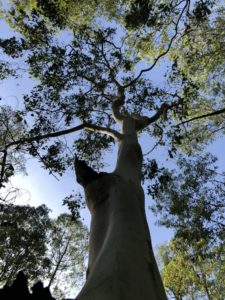 Below are three simple ways in which you can build vital energy in your body through meditation. They can be practised individually or in combination. They have the general meditation benefit of calming and focusing the body-mind, with the addition of specifically promoting the build-up and flow of life-force through the body.
Below are three simple ways in which you can build vital energy in your body through meditation. They can be practised individually or in combination. They have the general meditation benefit of calming and focusing the body-mind, with the addition of specifically promoting the build-up and flow of life-force through the body.
Method 1 – Relaxing into tension:
Rather than fighting and seeking to get rid of tension, discomfort or fatigue in your body, make a point of moving towards it and relaxing into it. Try and locate the principal areas of tension in your body. Once you have identified them, take some time to work with each one in turn. Take a few breaths where as you inhale you allow yourself to feel the tension in that part of the body. Then, as you exhale relax into it and release. The principle here is that, if you focus attention on the area of the body where energy is blocked and work on releasing it, that will allow new energy and vitality to flow into that area of the body. Let your body relax so that vital energy can flow easily to areas where it is needed.
Method 2 – Breathing into your belly
In both the Zen and Qi gong traditions of meditation, there is a lot of emphasis upon breathing into the belly area, where the core of your body’s life-force (see my article on the Dan-tiens in qi gong) is said to be located. Initially, simply placing the palm of one hand on your belly, just beneath the belly button, and focusing on the rising and falling of the abdomen is a good way to start. Then once you have basic familiarity, you can visualize a ball of light about the size of a tennis ball sitting within the centre of the lower belly area. As you breathe in, see the ball glowing gently with vitality and life-force. As you breathe out see the light and energy from the ball expanding out into the rest of your body, filling it with energy. If you do this consistently, you will find that you have a real, tangible feeling of this energy building and expanding as you do the exercise.
Method 2 – Sitting like a pyramid
If you want to bring a sense of solidity and grounded-ness into your belly breathing, imagine your body as being like a pyramid as you sit and do the belly breathing. Imagine your hips and belly are like the broad base of the pyramid, with your chest and head tapering up to a point, so your hips and belly are super stable and broad. As you breathe in and out of the belly, release tension from your upper body downwards into the belly and hips, building the feeling of strength and stability.
Adding a smile
A final simple method you can combine with any of the above methods; add a gentle half smile into the mix:
- As you release tension from the parts of your body, smile to them gently and warmly
- As you breathe in and out of the belly, imagine the energy is warm and smiling, positively radiating out from the belly into the rest of the body.
Wishing you enjoyment with your experience of mindful vitality!
Related articles:
Mindful Centring – three sitting positions
Breathing from your belly
Article and picture © Toby Ouvry 2019, you are welcome to use or share this article, but please cite Toby as the source and include reference to his website www.tobyouvry.com
All Courses at Integral Meditation Asia for February
Ongoing on Wednesday’s, 7.30-8.30pm – Wednesday Meditation Classes at Basic Essence with Toby
Ongoing on Tuesday evenings, 7.30-8.30pm – Tuesday Meditation Classes at One Heart with Toby (East coast)
Monday 6.15-7.15 & Wednesday 12.15-1.15 – Integral Meditation classes at Space2B on Stanley Street
Saturday mornings 9-10.15am, 16th & 23rd February – Qi Gong workout and meditation class
Saturday 23rd February 11-12.30pm – Get your meditation practice started now- The shortest and most time effective meditation workshop ever
Saturday 23rd February, 3.30-5.30pm – Developing Your Self-Confidence Through Mindfulness Workshop
Integral Meditation Asia
Online Courses * 1:1 Coaching * Books * Live Workshops * Corporate Mindfulness Training *Life-Coaching * Meditation Technology




 Making mindful use of your to-do list
Making mindful use of your to-do list



